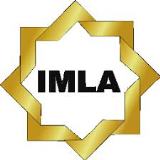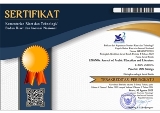Analyzing “Learn Arabic for Beginners” TikTok Content Based on the CEFR
تحليل محتوى تعليم اللغة العربية على تطبيق تيك توك في ضوء الإطار الأوربي المشترك للغات: “Learn Arabic for Beginners” أنموذجا
DOI:
https://doi.org/10.18326/lisania.v9i1.272-300Keywords:
CEFR, Arabic Materials, Linguistic Competence, Linguistic ActivitiesAbstract
This study aims to evaluate the Arabic language learning content featured on the TikTok account “Learn Arabic for Beginners” about the Common European Framework of Reference for Languages (CEFR), specifically targeting A1–A2 levels for beginner learners. Additional objectives include assessing the extent to which the content aligns with linguistic competencies (vocabulary, phonology, grammar) and language activities (reception, production, interaction, and mediation) as outlined by the CEFR descriptors. The study used a content analysis method with a descriptive qualitative approach, using purposive sampling to select highly interacted videos for in-depth analysis. The findings indicate that the majority of the content complies with A1–A2 proficiency levels, particularly demonstrating clear mastery of phonological elements and basic vocabulary. The platform supports receptive and productive language activities effectively. However, the interactive and mediational components remain underdeveloped and could be improved through features such as duet videos, live sessions, and audience engagement in comments. This research contributes theoretically to digital Arabic language pedagogy aligned with CEFR standards. It offers practical insights for educators and content creators to design more structured, engaging, and level-appropriate learning materials for beginner Arabic learners.
References
Al-Azawei, Ahmed, and Ali Alowayr. 2025. “Predicting the Acceptance of Informal Learning Technologies: A Case of the TikTok Application.” Education Sciences 15(3):362. https://doi.org/10.3390/educsci15030362.
Al-Azawei, Ahmed, and Karsten Lundqvist. 2015. “Learner Differences in Perceived Satisfaction of an Online Learning: An Extension to the Technology Acceptance Model in an Arabic Sample.” 13(5).
Amzaludin, Amzaludin, Indhun Qurottul Ain, and Eka Silfia Khumairah. 2023. “Akun TikTok (@kampungarabalazhar) Sebagai Media Belajar Bahasa Arab Online.” Jurnal Simki Pedagogia 6(2):554–65. https://doi.org/10.29407/jsp.v6i2.331.
Beinhoff, Bettina. 2019. “The Common European Framework of Reference for Languages: A European Framework for Foreign Language Speech Development.” Language Value 6(1):51–73. https://doi.org/10.6035/LanguageV.2014.6.5.
Ceci, Laura. 2025. “TikTok - Statistik & Fakta.” https://www.statista.com/topics/6077/tiktok/.
Dalimunthe, Miftahul Nizah, and Fatma Yulia. 2023. “Analisis Materi Ajar Bahasa Arab pada Akun Tik-Tok @kursusarabalazhar.” Tsaqofiya : Jurnal Pendidikan Bahasa dan Sastra Arab 5(2):214–31. https://doi.org/10.21154/tsaqofiya.v5i2.274.
Europe, ed. 2001. Common European Framework of Reference for Languages: Learning, Teaching, Assessment. 10th print. Cambridge: Cambridge Univ. Press.
Europe, Council of. 2020. Common European Framework of Reference for Languages: Companion Volume. Namur: Council of Europe.
Gan, Chin Lay, and Vimala Balakrishnan. 2016. “An Empirical Study of Factors Affecting Mobile Wireless Technology Adoption for Promoting Interactive Lectures in Higher Education.” The International Review of Research in Open and Distributed Learning 17(1). https://doi.org/10.19173/irrodl.v17i1.2111.
Golonka, Ewa M., Anita R. Bowles, Victor M. Frank, Dorna L. Richardson, and Suzanne Freynik. 2014. “Technologies for Foreign Language Learning: A Review of Technology Types and Their Effectiveness.” Computer Assisted Language Learning 27(1):70–105. https://doi.org/10.1080/09588221.2012.700315.
Harwood, Tracy, and Tony Garry. 2003. An Overview of Content Analysis: Ingenta Connect. Vol. 3. Westburn Publishers.
Jah, Nurain Jantan Anua, Nurus Syahidah Tahreb, Qistina Ibrahim, Intan Fitri Aisyah Hamzah, and Nurhazwani Abd Halim. 2024. “TikTok as Pedagogical Tool for English Language Learning: A Systematic Literature Review.” Gading Journal for the Social Sciences 27:101–11. https://doi.org/10.24191/gading.v27i0.548.
Juliar Fahri, Ahmad, and Rinaldi Supriadi. 2023. “Implikasi CEFR Pada Buku Ajar Sahabatku Indonesia Untuk Penutur Bahasa Arab Level 1.” Madah: Jurnal Bahasa dan Sastra 14(1):103–11. https://doi.org/10.31503/madah.v14i1.552.
Khoirotun Nisa, Pia, Mutia Hana, Syawla Malika Azzahra, Muhammad Bintang Prayoga, Jafar M. Az Zarkasyi, and Azka Aisul M. 2024. “Peran Aplikasi Tiktok Dalam Transformasi Perilaku Mahasiswa.” 2(5):145–57. https://doi.org/10.5281/ZENODO.14553612.
Li, Zhiqing, Janis Zhiyou Li, Xiaofang Zhang, and Barry Lee Reynolds. 2024. “Mastery of Listening and Reading Vocabulary Levels in Relation to CEFR: Insights into Student Admissions and English as a Medium of Instruction.” Languages 9(7):239. https://doi.org/10.3390/languages9070239.
Masita, Ella, Duti Volya, Dian Anggraini, Atika Kumala Dewi, Dewi Susilawati, Mukhlas Abrar, Lilik Ulfiati, Nely Arif, Masbirorotni, Saipul Effendi, Rahmah, and Nunun Fajaryani. 2024. Kurikulum Merdeka Dan Pengajaran Bahasa Inggris Di Era Digital. 1st ed. Kota Malang: PT. Literasi Nusantara Abadi Group.
McLeod, Saul. 2025.“Zona Perkembangan Proksimal Vygotsky.” https://www.simplypsychology.org/zone-of-proximal-development.html.
Milhinhos, Patricia Raquel Vasques. 2015. “The Impact of Content Marketing on Attitudes and Purchase Intentions of Online Shoppers : The Case of Videos & Tutorials and User-Generated Content.” Universidade Catolica Portuguesa, Portugal.
Nurdianto, Talqis. 2022. “CEFR-Based Beginner Arabic Reading And Writing Curriculum Design In Indonesia.” Ijaz Arabi: Journal of Arabic Learning 5(3):718–38. https://doi.org/10.18860 /ijazarabi.v5i3.16684.
Oyelaran, Olasope O. 2015. “Aspects of Linguistic Theory in Firthian Linguistics.” Tandfonline 23(1–3):428–52. https://doi.org/10.1080/00437956.1967.11435497.
Patty, Jusak, and Libreck F. A. Noija. 2023. “Social Media Revolution: TikTok’s Impact On English Language Learning.” Jurnal Review Pendidikan Dan Pengajaran 6(4):937–45. https://doi.org/10.31004/jrpp.v6i4.20610.
Pebrimireni, Davina, and Diena San Fauziya. 2024. “Analisis Penggunaan Aplikasi TikTok Sebagai Media Pembelajaran Bahasa Indonesia Dalam Upaya Peningkatan Motivasi Belajar Siswa.” Jurnal Bima : Pusat Publikasi Ilmu Pendidikan bahasa dan Sastra 2(3):169–78. https://doi.org/10.61132/bima.v2i3.1040.
Pennycook, Gordon, and David G. Rand. 2019. “Fighting Misinformation on Social Media Using Crowdsourced Judgments of News Source Quality.” Proceedings of the National Academy of Sciences 116(7):2521–26. https://doi.org/10.1073/pnas.1806781116.
Prahaladaiah, Diwakar, and Kennedy Andrew Thomas. 2024. “Effect of Phonological and Phonetic Interventions on Proficiency in English Pronunciation and Oral Reading” edited by S. S. Aga. Education Research International 2024:1–18. https://doi.org/10.1155/2024/9087087.
Priantiwi, Tiara Nurfingkan, and Maman Abdurrahman. 2023. “Analisis Konten Pembelajaran Bahasa Arab Pada Media Tiktok.” Jurnal Ilmiah Profesi Pendidikan 8(3):1365–71. https://doi.org/10.29303/jipp.v8i3.1502.
Rahimullah, Nadia Adilah, Sinta Bela Damayanti, Aisyah Amyra Izra, and Putu Wuri Handayani. 2022. “Assessing the Factors Influencing Users Accessing Higher Education Content on TikTok.” Cogent Education 9(1):2148498. https://doi.org/10.1080/2331186X.2022.2148498.
Sabater, Carmen Pérez, Enrique Cerezo Herrero, and Inmaculada Ortuño. 2023. “TikTok/Flipgrid for Foreign Language Learning in Higher Education: A Case Study.” Íkala, Revista de Lenguaje y Cultura 29(1):1–19. https://doi.org/10.17533/udea.ikala.353501.
Sit, Masganti. 2012. Perkembangan Peserta Didik. Vol. 1. Medan: Perdana Publishing.
Sujinah, Sujinah, Eko Supriyanto, and Tining Haryanti. 2022. Panduan Penetapan Bahan Ajar Sekolah. Kota Surabaya: UM Publishing.
Syakirah, Hana, and Imam Santosa. 2024. “The Communicative Language Strategies of CEFR in TikTok Video.” Stairs 5(1):25–34. https://doi.org/10.21009/stairs.5.1.3.
Tomlinson, Carol Ann, Catherine Brighton, Holly Hertberg, Carolyn M. Callahan, Tonya R. Moon, Kay Brimijoin, Lynda A. Conover, and Timothy Reynolds. 2003. “Differentiating Instruction in Response to Student Readiness, Interest, and Learning Profile in Academically Diverse Classrooms: A Review of Literature.” Journal for the Education of the Gifted 27(2–3):119–45. https://doi.org/10.1177/016235320302700203.
Wibowo, Firmanul Catur, Lari Andres Sanjaya, Dina Rahmi Darman, Upik Rahma Fitri, Erwina Oktavianty, Eka Afrida Ermawati, Hadi Nasbey, Ira Mahartika, Arif Widyatmoko, Leny Dhianti Haeruman, and Al Farizi Ade Karlin Kusuma. 2023. Pembelajaran Nano Learning Berbasis STEM. 1st ed. Yayasan Kita Menulis.
Yahaya, Nurhafizah, and Nuraqilah Nadjwa Miskam. 2025. “Media Literacy in the Digital Age: Examining the Use of Tiktok to Enhance Speaking Skills.” International Journal of Academic Research in Business and Social Sciences 15(2):1–16. https://doi.org/10.6007/IJARBSS/v15-i2/24385.
Yang, Yuxin, and Instructor Elana Zilberg. 2020. “Understanding Young Adults’ TikTok Usage ----- Real People, Creative Videos That Makes Your Day.”
Yüce, Erkan. 2020. “Online Conversations and Discussions Based on the CEFR-Companion Volume Descriptors for Foreign Language Teaching in Digital Contexts.”
Zulfa, Shofiyah Sausan, and Miftahul Rozaq. 2024. “Teknologi Sebagai Sumber Kepuasan: Bukti Kepuasan Baru Media Sosial Tiktok di Kalangan Dewasa Muda.” JIIP - Jurnal Ilmiah Ilmu Pendidikan 7(6):5747–57. https://doi.org/10.54371/jiip.v7i6.4500.
Zulkepli, Muhamad Khairul Anuar Zulkepli, Mohd Fahimi Zakaria, and Mohd Adi Amzar. 2025. “The Role of TikTok in Promoting Arabic Language Learning among Millennials and Gen Z.” International Journal Of Research And Innovation In Social Science 9(3). https://doi.org/10.47772/IJRISS.
Downloads
Published
Issue
Section
License
Copyright (c) 2025 Dita Puspita Dewi, Gita Putri Ramadhani, Asep Sopian

This work is licensed under a Creative Commons Attribution-NonCommercial-ShareAlike 4.0 International License.






